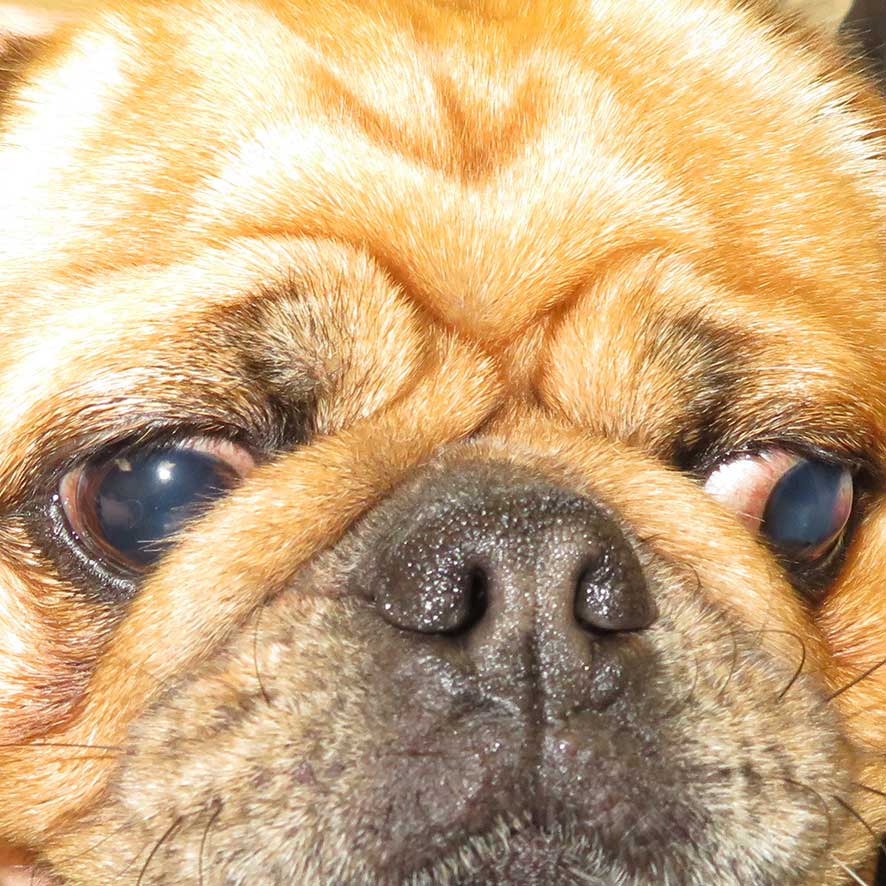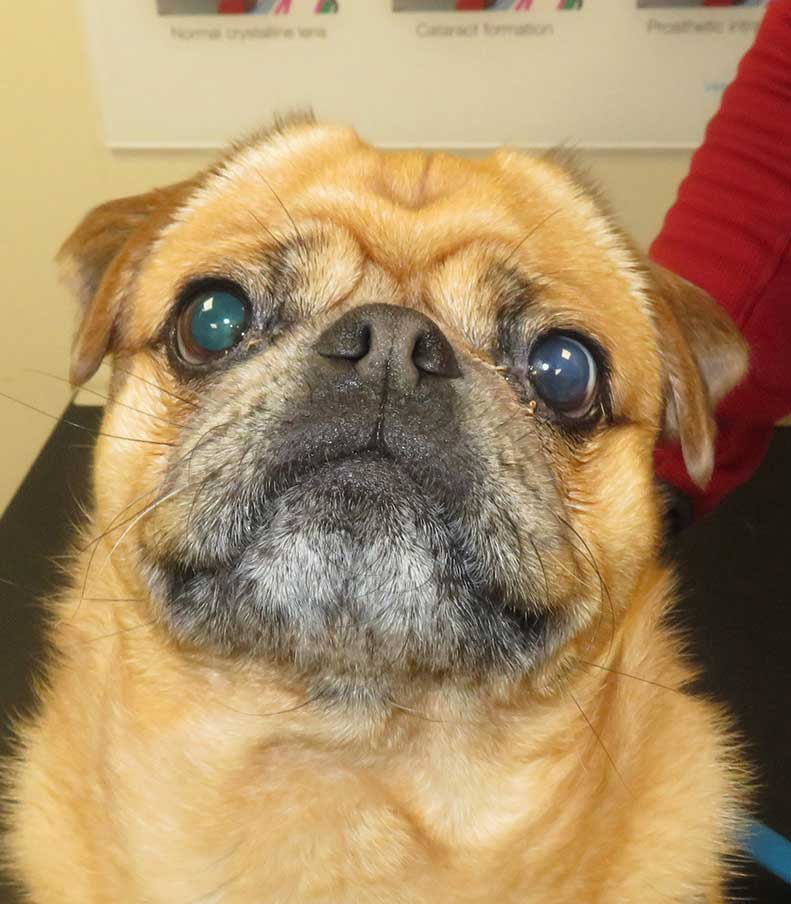17 Jan 2025
Caring for brachycephalic dog breeds’ optical health
Referral nurses Rachel Forrest and Millie Motley consider the importance of being informed when dealing for these patients and the difference vet nurses can make.
As ophthalmic veterinary nurses working in a busy referral centre, we encounter many breeds and species, but a higher percentage of brachycephalic patients are referred to us for treatment when compared to mesocephalic breeds.
Brachycephalic breeds, characterised by their shortened skulls and distinctive facial features, are beloved by many for their unique appearances. However, these breeds are predisposed to several health issues, particularly concerning their eyes. A word used to describe the characteristics of brachycephalic dogs, “kindchenschema”, relates to larger, more bulging eyes and large foreheads. This is what attracts humans due to their likening to infant babies, which therefore naturally makes people feel nurturing towards them.
As veterinary nurses, our role in managing and supporting these patients is crucial to their well-being. This article aims to provide accurate knowledge and a positive approach so you can play a key role in helping to keep patients’ eyes healthy. In this article we will review brachycephalic ophthalmology care and how you can make a difference in general practice.
Understanding unique anatomy
These lovable flat-faced breeds have a facial anatomy that leaves their eyes more susceptible to disease. Their shallow eye sockets (orbits) and, commonly, excessive eyelid length (macroblepharon) cause the eyeballs to protrude more than in longer-faced breeds. This dramatic exposure of the eyeballs results in reduced nerve sensation of the cornea, which can lead to ocular problems going unnoticed by owners until the very late stages of corneal disease. Additionally, the abnormal positioning of their eyelids often leads to incomplete blinking, also called “lagophthalmos”, leaving the eyes insufficiently lubricated and more prone to tear film abnormalities.
These conformational factors pose brachycephalic patients at a much higher risk of ocular injuries, such as corneal ulceration, foreign bodies and even proptosis when compared to longer-faced breeds.
By embracing their specific needs, you’re not just treating their conditions, you are also enhancing their quality of life and keeping those big, beautiful eyes healthy and shining bright.
Common ophthalmic conditions in brachycephalic breeds
Corneal ulceration
Corneal ulcers are perhaps the most commonly treated ailment in the brachycephalic breed. The protruding eyes are more susceptible to trauma from external objects, rubbing or even from stray hairs (trichiasis) in their own facial folds.
Early detection and prompt treatment are essential to prevent these ulcers from worsening, potentially leading to perforation or vision loss.
Squinting (blepharospasm), rubbing and excessive tearing of the eye can be quick indicators that further investigation is needed to assess corneal health. This can be done in general practice using hand-held devices such as a focal light source or an otoscope with a magnifying lens.
Using illumination to assess the eye can indicate whether there is evidence of mechanical abrasion (for example, entropion) or a foreign object (for example, thorn) within the tissues around the eye, irritating the cornea.
Secondly, if a corneal ulcer is suspected, the application of fluorescein dye to the cornea will aid in the assessment of the corneal ulcer. A corneal ulcer should be categorised by size, depth and cause, and you should consider the possibility of associated infection.
Depending on the severity of the condition, a treatment plan can be prescribed by the veterinary surgeon. In the case of serious ocular disease or injury, referral for expert ophthalmological care may be necessary (Figure 1).
Keratoconjunctivitis sicca (dry eye)
Due to their compromised blinking ability, brachycephalic animals often suffer from dry eye due to excessive tear evaporation between blinks. Dry eye is a condition in which the eyes do not produce enough tears or an adequate quality of tears to keep the cornea well lubricated.
Chronic dry eye disease can lead to ocular discomfort, redness, secondary infections and corneal ulcers. Recognising this condition early and initiating treatment, such as tear supplementation medication, can greatly improve the quality of life of these pets. In some cases, the dry eye may be particularly severe or unresponsive to treatment, which is an indication that referral may be necessary.
Pigmentary keratitis
Pigmentary keratitis is a potentially blinding condition, marked by the development of dark pigmented areas on the cornea, often resulting from chronic irritation or inflammation. Initial assessment may find hairs from nasal folds or from the eyelid caused by entropion contacting the cornea, rubbing against it and causing chronic irritation.
Surgical correction and specialised medical treatment can be initiated at referral centres that are well equipped to tailor eye drop regimes or laser procedures to reduce and control the formation of pigment cells forming on the cornea (Figure 2).

Entropion and ectropion
Entropion (inward rolling of the eyelids) and ectropion (outward rolling of the eyelids) are conditions frequently encountered in brachycephalic breeds due to their abnormal eye and eyelid confirmation. These conditions can cause significant irritation and exposure of the cornea, leading to chronic pain, scarring and potential ulceration. Surgical intervention will often be required with these patients.
Proptosis
Due to shallow orbits, brachycephalic dogs and cats are at risk for proptosis (prolapse of the eyeball from the orbit). Brachycephalic patients are more susceptible to this due to the over-long eyelids and shallow orbits, meaning the eye is not securely held in place within the orbit. This is an emergency that requires immediate attention, and the eye should be kept lubricated to preserve corneal health until a treatment plan has been made.
Brachycephalic ocular syndrome
Brachycephalic ocular syndrome involves various eyelid, conjunctival and corneal abnormalities commonly found in brachycephalic breeds. It often presents with a combination of issues, such as exophthalmos due to shallow orbits, exposure keratitis from lagophthalmos, and pigmentary keratitis.
Surgical intervention is typically required, with procedures such as a medial canthoplasty, which may address multiple issues simultaneously. Postoperative management usually involves ongoing medication to maintain optimal ocular health. Given the complexity of eyelid surgery, referral to a veterinary ophthalmologist is recommended.

Your role as a veterinary nurse and how you can help
As veterinary nurses, we are at the front line of patient care and client education.
Our responsibilities towards improving the knowledge of brachycephalic owners can include:
Monitoring and early detection
Regular eye examinations are essential for brachycephalic breeds. As part of routine care, you should be vigilant in checking for signs of scleral redness, ocular discharge, excessive tearing, squinting or changes in eye colour.
If any of these symptoms are discovered, further investigation should always be carried out and a referral should be considered in cases of serious concern. Early detection of these symptoms can prevent minor issues from escalating into a more serious condition.
Client education
Educating owners is a key aspect of managing brachycephalic eye and general health conditions. Many owners may not be aware of the risks associated with their pet’s breed, and it is our job as nurses to urge them to understand the risks of brachycephalic conformation.
Providing guidance on how to recognise early signs of eye problems, as noted previously, the importance of regular eye cleaning and observation to check for chronic or acute changes, and the awareness of the need for prompt veterinary attention can significantly improve outcomes.
Nursing clinics are a great opportunity to have brachycephalic tailored consultations to help guide owners in the care of their pet. One simple way to drive owners to being committed to their pet’s ocular health is regular lubrication.
Due to the conformation of brachycephalic breeds, it is never detrimental to use a regular lubricating drop such as Remend Gel or Optixcare Plus several times a day, which will aid in protecting the eye from drying out, and reducing irritation from any hairs that may be coming into contact with the cornea on a day-to-day basis.
Surgical nursing of ophthalmic patients
When surgical intervention is necessary (not just in ophthalmic practice), our role in pre, peri and postoperative care is critical to ensure that the eyes are well looked after. Lubrication throughout surgery and postoperatively is essential for all breeds and species, but particularly important for brachycephalics to minimise corneal complications. It can be quite common for patients to suffer from dry eye following anaesthetics during surgical procedures.
It is worth noting that some anaesthetic drugs can carry a risk of vomiting and nausea. With brachycephalic patients in mind, it is important to be aware that regurgitation is already a risk for these patients and vomiting and regurgitation can cause a spike in intraocular pressure. Therefore, it might be wise to tailor anaesthetic protocols to brachycephalic dogs by using antiemetics and antacids.
Administration of medication
Accurate and consistent administration of eye medications is crucial in treating ophthalmic conditions. Ensuring that medications are given on time and correctly can make a significant difference in the recovery process.

Providing owners with clear instructions and demonstrations on the administration of topical eye medication can greatly improve compliance and treatment efficacy.
Emotional support
Caring for a pet with chronic eye issues can be stressful for owners. Offering reassurance, answering questions and providing empathetic support are essential components of our role as veterinary nurses.
Compassion and dedication to both the owner and the patient can greatly influence the owner’s positive experience and improve the overall well-being of their pet.
A brighter future with your care
Caring for brachycephalic breeds with or without ophthalmic concerns requires a proactive and informed approach. As veterinary nurses, our role is indispensable in ensuring these pets receive the best possible care. By staying informed, educating clients and providing compassionate support, we can make a significant impact on the lives of these special animals.
Remember, early detection and intervention are pivotal in managing these conditions and preventing long-term complications. Keep shining in your role and continue making a lasting impact on the lives of these special animals. Their eyes, and their owners, will thank you for it.
- Anyone with an interest in learning more about ocular diseases, Veterinary Vision holds regular free CPD sessions and is also available to travel to your practice for lunch and learn sessions. Contact relationship manager Nicola Atkins for information.
